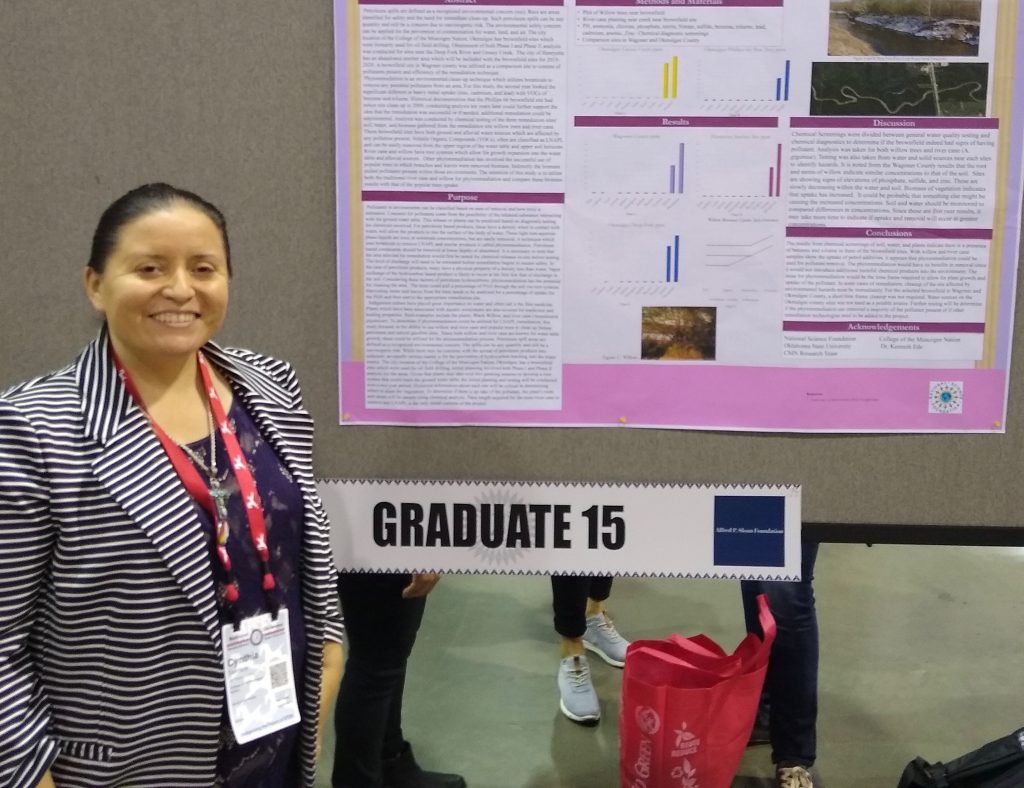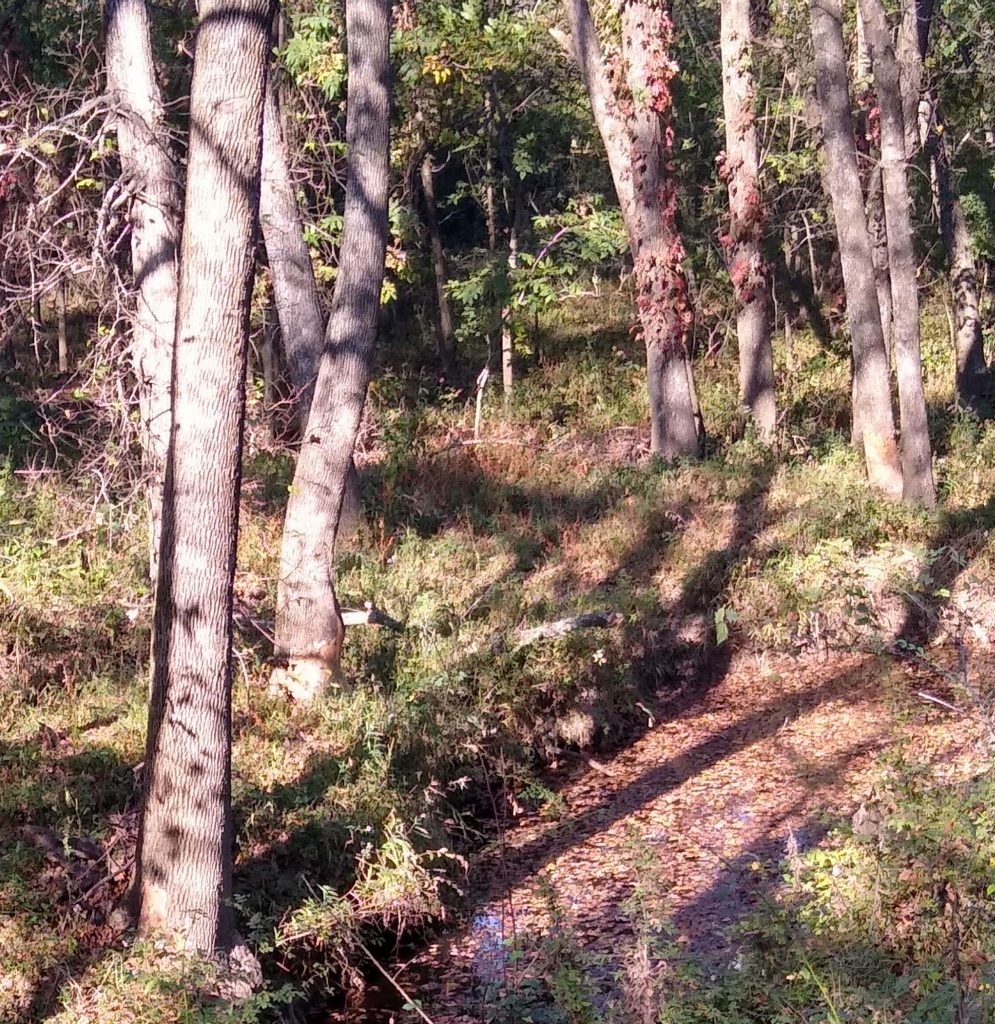Students at the College of the Muscogee Nation in Oklahoma are using plants to remove heavy metals from wetlands contaminated by oil drilling and other industries.
By Melanie Lenart

In Cynthia Sanders’ General Biology course at the College of the Muscogee Nation, students learn how to assess water quality in their communities and actively work to restore wetlands damaged by decades of oil drilling and outside industry.
If it sounds like a lot to expect from new college students, they do have some allies. They’ve got Sanders herself, a science instructor who typically guides 120 students or so each year in personalized projects in water quality. And they also have help from plants that can clean up heavy metals such as arsenic, zinc and cadmium from contaminated sites.
“We’ve actually looked at how different plants have able to pull materials out of the environment. We’ve also sampled the soils and sampled the water nearby,” said Sanders, a citizen of the Muscogee Nation who grew up near one of the research sites. “And of course, there are different chemical components for each site based on history.”
Pandemic-permitting, students collect samples from contaminated wetland sites, carry out lab tests to assess the presence of chemical compounds and heavy metals, and report their findings in poster presentations. Some of her students will be presenting on aquatic health at the First American Land-Grant Consortium annual conference to be held online October 21-22.
“You get up in the morning and you’re very excited for the students,” Sanders said over a Zoom call in mid-September from her office on the Okmulgee, Oklahoma-based campus. Like many other science instructors and researchers, she has found that undertaking hands-on experiences that pose benefits for the community is a strong way to engage students, especially those from tribal nations.
Sanders noted that the “ogee” sound—spelled “owv” or “uewv” in the Muscogee language—relates to a description of water. Water is far more abundant in their original homelands—much of the southeastern U.S.—where the Muscogee traditionally lived in mounds and, later, towns along rivers. This led the Europeans who met them to call them “Creek” Indians, and the tribe was known as the Muscogee (Creek) Nation until just this past May.
Water remains important to the Muscogee, known to themselves as Este Mvskokvlke, who live on the Oklahoma land where they were forced to relocate during the Trail of Tears in the 1830s.
Unfortunately, water contamination became a major issue during the past century. Federal laws, such as the Dawes and Curtis acts, resulted in a loss of roughly 2 million acres of land from the section of Oklahoma ascribed to them in the decades leading up to the 1907 passage of statehood. People from outside the tribe now own the majority of land on the designated reservation, with Tulsa situated at the north and the Canadian River marking the southern border with the Choctaw Nation. The tribal college is situated roughly in the middle of the Muscogee Nation in the tribe’s capitol city of Okmulgee.
When oil was discovered on the land in the 1930s, those laws and others made it lucrative and easy for outsiders to set up oil rigs and other industry in their designated territory. The resulting patchwork of private and public and tribal lands now contains numerous brownfields—which is what the Environmental Protection Agency calls property containing the presence or possible presence of a hazardous substance, pollutant or contaminant.

Although the U.S. Environmental Protection Agency doesn’t maintain a list of existing brownfields, EPA Senior Pubic Affairs Specialist Catherine C. Milbourn noted that the agency so far has provided some funding for the clean-up of 94 brownfields on the Muscogee Nation.
Three brownfields have been the target of Sanders and her students since 2016:
- A site along Okmulgee Creek, known locally as Greasy Creek for its continued oil sheen. The site the class monitors had been used as an oil refinery, with oil spewing into the creek for many years. Sanders and her students have found the contaminant toluene continues to pollute the site, as well as sulfide and arsenic.
- A site in Wagoner County, where Sanders was raised, which features abandoned natural gas pipelines originally put in by a company that went bankrupt. This site has been used for comparison.
- A site in the city of Henryetta that was used for metal mining and smelting, such as for zinc-oxidizing pipes. The class has measured the presence of the contaminants zinc, sulfide, cadmium and traces of lead in the soil and water around the site.
Later this year, she hopes to plant, with her students, a small plot of willow and river cane on the Muscogee Nation Conservation Office’s Hanna Farm. The goal is to provide a teaching tool regarding how plants can clean up pollutants, she explained.
Although the site has no history of pollutants, the plants might still help keep water cleaner by taking up excess nutrients, such as those associated with the waste from cattle raised at the farm. While manure serves as fertilizer for plants, its presence in water can create problems—in part because it encourages the growth of aquatic plants.
Sanders said that simply removing contaminated plants from a site to test for chemicals and heavy metals also serves as a form of remediation. Enlisting plants to help treat contaminated sites is known as phytoremediation.
“We’re trying to remove the chemicals off the site,” she said. “Our hope is later on, we want to be able to take those sources and be able to render them so we don’t have any zinc or it’s very little.”
Willow tree seems to be particularly good at removing contaminants, she noted. Willows grow right to the water’s edge, and they can grow in acidic soil. Researchers in Finland have estimated that, in some cases, willows can clear zinc from the soil in as little as six years.
“With the uptake of the biomass that we’ve been able to sample, we know that we’re seeing a removal,” Sanders said.
The class collects branches from the ground that would otherwise decay and release the heavy metals back into the environment. Instead, they promote the plant material’s decay in the lab during the 16-week class by turning them into a slurry that can be sampled for measurements. Sanders currently stores the material in containers on campus, but she’s working with a local landfill for eventual disposal.
Although it’s a preliminary finding, the repeat measurements taken by the students suggest that about 70 percent of the contaminating zinc has been removed from the Henryetta site since their efforts began in 2016. The sites have also benefited from the removal of zinc, arsenic and lead.
Even as Sanders is teaching her students, she is a student herself in a Ph.D. program at Oklahoma State University. She hopes to build upon these results as part of her dissertation research toward that degree. Perhaps even more than that, she hopes the projects will help clean up some of the brownfields on the Muscogee Nation and thus improve the local water quality.
“As of right now, this is more of an educational endeavor,” she said. “But our hope is that we can somehow show positive results and potentially remediate that region.”
• • •
Melanie Lenart is a regular contributor to Native Science Report.
Published October 5, 2021
• • •
